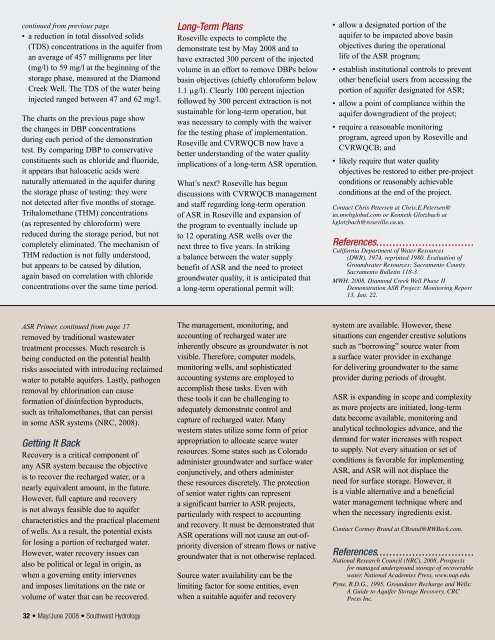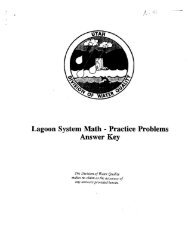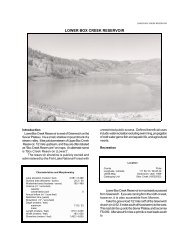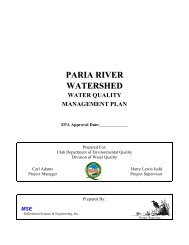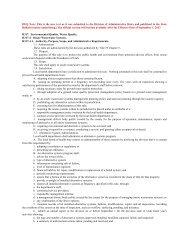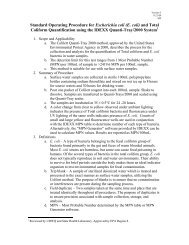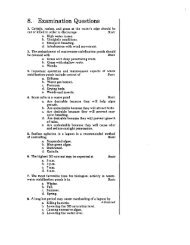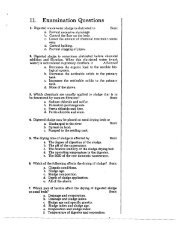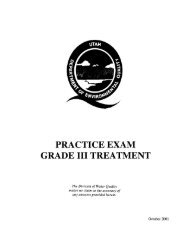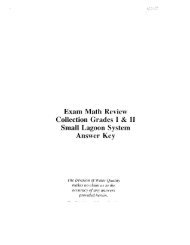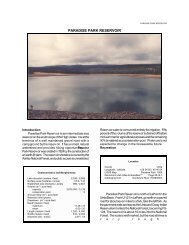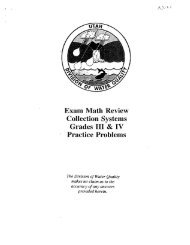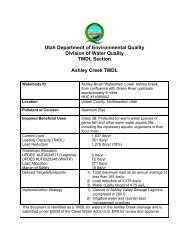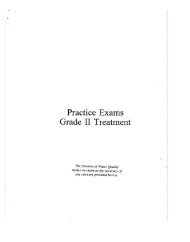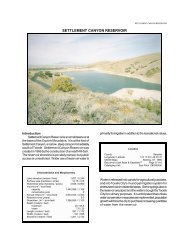Aquifer Recharge, Storage, and Recovery - Southwest Hydrology ...
Aquifer Recharge, Storage, and Recovery - Southwest Hydrology ...
Aquifer Recharge, Storage, and Recovery - Southwest Hydrology ...
- No tags were found...
You also want an ePaper? Increase the reach of your titles
YUMPU automatically turns print PDFs into web optimized ePapers that Google loves.
continued from previous page• a reduction in total dissolved solids(TDS) concentrations in the aquifer froman average of 457 milligrams per liter(mg/l) to 59 mg/l at the beginning of thestorage phase, measured at the DiamondCreek Well. The TDS of the water beinginjected ranged between 47 <strong>and</strong> 62 mg/l.The charts on the previous page showthe changes in DBP concentrationsduring each period of the demonstrationtest. By comparing DBP to conservativeconstituents such as chloride <strong>and</strong> fluoride,it appears that haloacetic acids werenaturally attenuated in the aquifer duringthe storage phase of testing: they werenot detected after five months of storage.Trihalomethane (THM) concentrations(as represented by chloroform) werereduced during the storage period, but notcompletely eliminated. The mechanism ofTHM reduction is not fully understood,but appears to be caused by dilution,again based on correlation with chlorideconcentrations over the same time period.Long-Term PlansRoseville expects to complete thedemonstrate test by May 2008 <strong>and</strong> tohave extracted 300 percent of the injectedvolume in an effort to remove DBPs belowbasin objectives (chiefly chloroform below1.1 µg/l). Clearly 100 percent injectionfollowed by 300 percent extraction is notsustainable for long-term operation, butwas necessary to comply with the waiverfor the testing phase of implementation.Roseville <strong>and</strong> CVRWQCB now have abetter underst<strong>and</strong>ing of the water qualityimplications of a long-term ASR operation.What’s next? Roseville has begundiscussions with CVRWQCB management<strong>and</strong> staff regarding long-term operationof ASR in Roseville <strong>and</strong> expansion ofthe program to eventually include upto 12 operating ASR wells over thenext three to five years. In strikinga balance between the water supplybenefit of ASR <strong>and</strong> the need to protectgroundwater quality, it is anticipated thata long-term operational permit will:• allow a designated portion of theaquifer to be impacted above basinobjectives during the operationallife of the ASR program;• establish institutional controls to preventother beneficial users from accessing theportion of aquifer designated for ASR;• allow a point of compliance within theaquifer downgradient of the project;• require a reasonable monitoringprogram, agreed upon by Roseville <strong>and</strong>CVRWQCB; <strong>and</strong>• likely require that water qualityobjectives be restored to either pre-projectconditions or reasonably achievableconditions at the end of the project.Contact Chris Petersen at Chris.E.Petersen@us.mwhglobal.com or Kenneth Glotzbach atkglotzbach@roseville.ca.us.ReferencesCalifornia Department of Water Resources(DWR), 1974, reprinted 1980. Evaluation ofGroundwater Resources: Sacramento County.Sacramento Bulletin 118-3.MWH, 2008. Diamond Creek Well Phase IIDemonstration ASR Project: Monitoring Report13, Jan. 22.ASR Primer, continued from page 17removed by traditional wastewatertreatment processes. Much research isbeing conducted on the potential healthrisks associated with introducing reclaimedwater to potable aquifers. Lastly, pathogenremoval by chlorination can causeformation of disinfection byproducts,such as trihalomethanes, that can persistin some ASR systems (NRC, 2008).Getting It Back<strong>Recovery</strong> is a critical component ofany ASR system because the objectiveis to recover the recharged water, or anearly equivalent amount, in the future.However, full capture <strong>and</strong> recoveryis not always feasible due to aquifercharacteristics <strong>and</strong> the practical placementof wells. As a result, the potential existsfor losing a portion of recharged water.However, water recovery issues canalso be political or legal in origin, aswhen a governing entity intervenes<strong>and</strong> imposes limitations on the rate orvolume of water that can be recovered.32 • May/June 2008 • <strong>Southwest</strong> <strong>Hydrology</strong>The management, monitoring, <strong>and</strong>accounting of recharged water areinherently obscure as groundwater is notvisible. Therefore, computer models,monitoring wells, <strong>and</strong> sophisticatedaccounting systems are employed toaccomplish these tasks. Even withthese tools it can be challenging toadequately demonstrate control <strong>and</strong>capture of recharged water. Manywestern states utilize some form of priorappropriation to allocate scarce waterresources. Some states such as Coloradoadminister groundwater <strong>and</strong> surface waterconjunctively, <strong>and</strong> others administerthese resources discretely. The protectionof senior water rights can representa significant barrier to ASR projects,particularly with respect to accounting<strong>and</strong> recovery. It must be demonstrated thatASR operations will not cause an out-ofprioritydiversion of stream flows or nativegroundwater that is not otherwise replaced.Source water availability can be thelimiting factor for some entities, evenwhen a suitable aquifer <strong>and</strong> recoverysystem are available. However, thesesituations can engender creative solutionssuch as “borrowing” source water froma surface water provider in exchangefor delivering groundwater to the sameprovider during periods of drought.ASR is exp<strong>and</strong>ing in scope <strong>and</strong> complexityas more projects are initiated, long-termdata become available, monitoring <strong>and</strong>analytical technologies advance, <strong>and</strong> thedem<strong>and</strong> for water increases with respectto supply. Not every situation or set ofconditions is favorable for implementingASR, <strong>and</strong> ASR will not displace theneed for surface storage. However, itis a viable alternative <strong>and</strong> a beneficialwater management technique where <strong>and</strong>when the necessary ingredients exist.Contact Cortney Br<strong>and</strong> at CBr<strong>and</strong>@RWBeck.com.ReferencesNational Research Council (NRC), 2008. Prospectsfor managed underground storage of recoverablewater, National Academies Press, www.nap.edu.Pyne, R.D.G., 1995. Groundater <strong>Recharge</strong> <strong>and</strong> Wells:A Guide to <strong>Aquifer</strong> <strong>Storage</strong> <strong>Recovery</strong>, CRCPress Inc.


